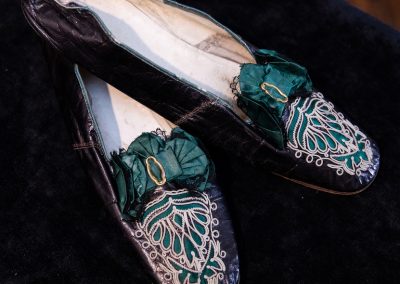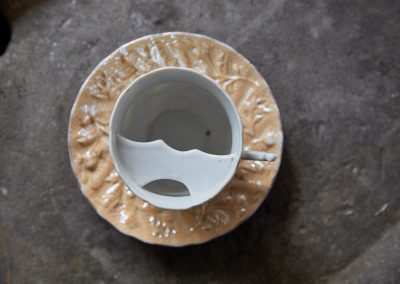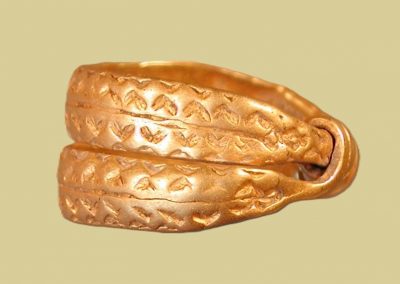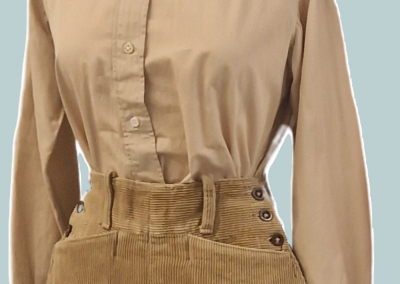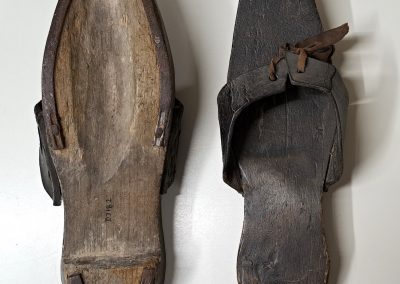Moustache cup and portraits
Ryedale Folk Museum and others
This unusual cup at Ryedale Folk Museum was produced with a special ledge or guard inside, giving us a clue to its owner.
Towards the end of the 19th century, any respectable Victorian gentleman would likely be found sporting a moustache. The ledge would ensure that the moustache stayed styled with wax whilst he sipped hot beverages. British potter Harvey Adams is credited with inventing it.
A moustache was a time-consuming accessory so this fashion was led by the upper, wealthier classes with the greatest leisure time.
Facial-hair fashions have come and gone throughout history, often linked to perceptions of masculinity.
The Crimean War has been cited as a cause of the return of facial hair amongst Victorian men, when heavy beards became associated with the heroism of the returning soldiers in 1856. Then, from 1860, Army regulations stated men should shave their chins but not their upper lip. This may have been a response to colonialism, since the British Army was stationed in India where Indian men often had large moustaches.
Whose face would you want on your cup?
Moustache cups rose in popularity from the 1870s. This cup is decorated with an image of Field Marshal Frederick Sleigh Roberts.
Roberts was regarded in his time as one of Britain’s most successful military campaigners due to his role in the Second Anglo-Afghan War (1878-80) and again during a year of the second Anglo-Boer War (1899 – 1902). His inclusion on the cup is likely down to his notable whiskers and heroic status. It gives us an interesting insight into attitudes towards ‘heroic’ figures at the time.
Facial hair fashions in portraits
We see facial hair fashions show up in portraiture too, like this painting of ‘J.H. Wilson, Mayor of Harrogate’.
It was painted by Thomas Holroyd in 1897 and is part of the collection at The Mercer Art Gallery in Harrogate
Likewise, you can see ‘Captain Henry Darley’ (late 19th century), with a moustache in his portrait Scarborough Art Gallery’s collection.
These two portraits would both have been commissioned to show these men, who were considered important in their time, in all their regalia and looking their finest.
Vocabulary
Regalia: the emblems and signs that show status, including the objects and ornaments worn and carried, such as mayoral chains, and clothing such as formal robes. Royal regalia includes the crown and sceptre.
Commission: when an artist is paid to produce a custom-made work of art
Do you think cups like these were a ‘gimmick’ or do you think they were useful items?
Do you think they would have been difficult to produce? Explore the cup and saucer’s other design features. What evidence is there that this would have been an expensive cup?
How can you tell from the portraits that it was ‘men of distinction’ who wore moustaches at that time?
Why do you think the cup is decorated with an image of Field Marshal Roberts? What does that tell us about how he was regarded?
Whose portrait would you choose to put on a cup today?
Why do you think people follow facial hair fashions? What sorts of facial hair are fashionable today? Do you ever use styling wax?
Are there any fashions today which you think might feel silly in later years?


In the Classroom
Hotseat
Interview a student in role as the owner of the moustache cup.
Why does he use it? What happened when he didn’t have a moustache cup? Could he ever imagine shaving off his moustache? What made him choose a cup design featuring Field Marshal Roberts?
Debate
Can you see this cup design ever becoming popular again? Hold a two-minute speed debate to find out whether students believe the cup is a useful item of crockery or a useless gimmick.
Introduce the debate motion: the moustache cup deserves a second chance. You can read tips for formalising debates. You could appoint a member of the class to be in favour and a member against and brainstorm ideas quickly before your vote.

Hands on History
Explore more incredible objects displayed across more than 20 heritage buildings at Ryedale Folk Museum in the North York Moors.
You can explore more art, including portraiture, at Scarborough Art Gallery – and children can visit for free!
Find out more about these museums by clicking on the pins.
Find out more about changing attitudes to body image & fashion








